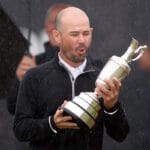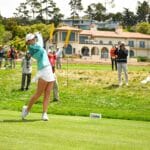There’s not many things that unite the internet nowadays, so Patrick Cantlay, take a bow. It’s a pity he seldom visits the Middle East because his slow play could bring the Israelis and the Palestinians together as they realise they’ve been battling the wrong enemy all along.
Slow play is a blight on the game at all levels, and it’s largely the pros that are doing the damage as the ‘monkey see, monkey do’ phenomenon creeps into the casual player.
But how to police that in the amateur game? Sure, a course ranger helps, giving particularly slow groups a nudge along, but that doesn’t really have the desired effect as players might pick up the pace for a hole or two before settling back into their tediously slow normality.
However, it can be policed in the professional ranks. Slow play penalties are handed out once in a blue moon on the PGA and DP World Tours, and the time a player takes to hit a shot is only ever assessed when a group is judged to be out of position and put on the clock, but it’s hard to get that far out of position when the group in front are glacially slow as well.
The most simple way of combating slow play isn’t to start timing players when they fall behind, it’s to set a time limit at the start of the day and stick to it. If the first group of the day is given a four-and-a-half-hour time limit for three-balls and a four-hour limit for pairs, and there’s a two-stroke penalty per player dished out for every additional ten minutes they exceed the limit, then timing wouldn’t be an issue.
It would be the players’ own responsibility to ensure their group finishes on or ahead of schedule. So, what if you’ve a group of Brooks Koepka, Matt Fitzpatrick and the aforementioned Cantlay? Two notoriously fast players and, well, Patrick Cantlay? There are already tour officials, walking scorers etc. with each group, have one of them time each player’s shot and keep track. If 40 seconds is the standard allowed when a group are on the clock, then if a group exceed the time limit, divide each player’s total time taken by the number of strokes hit.
If, for example, the Koepka, Fitzpatrick and Cantlay group are five minutes over, and Koepka and Fitzpatrick both come in sub-40 seconds per stroke, and Cantlay is a minute-plus, then Cantlay gets the full six strokes for the group. If it’s just Koepka under the bar, then it’s three-strokes each for the other two.
This is gross. I thought it was like how the DP World Tour did Adrian Meronk dirty with that April Fools gag. Sadly it’s just Patrick Cantlay taking the absolute piss. Kick him off the tour, Doug pic.twitter.com/b2ca1AT45n
— John Craven (@Ace_Craven) April 13, 2023
That would certainly put an end to players taking two-minutes to line up a putt, or waggling for thirty seconds before they pull the trigger on a full shot, but there’s still another major contributor to slow play that it won’t address and that’s rulings and drops. Yes we want fans at events, and more importantly, sponsors want fans at events, so as long as there are going to be grandstands, TV towers, etc. then occasionally they will come into play.
The simplest and speedy-golf friendly solution to this is to create a drop zone on every hole, in a difficult enough position to make players less likely to launch balls deliberately into the stands, knowing that they’ll get a free drop and if they’re smart enough, they’ll drop it on a spot where the ball will inevitably move and they’ll then get to place. And that’s bulls**t. If you hit a shot bad enough to end up in the stand, either play it from there or drop it in the zone, no alternatives.
If the alternative to playing a shot from row Z is a stinky pitch over a bunker from a bad lie in thick rough, there’ll be a lot less balls in the grandstands, I can promise you that. There’ll be no players taking exaggerated wide stances and unconventional practice swings to attempt to prove that the full 6-iron they were going to hit from 20 yards left of the green might catch the temporary immovable object in their backswing.
Okay, I’m going a little over the top with that last one, but if we’re serious about speeding up pace of play, there are options.
I might not make for a popular commissioner amongst the player ranks, but without an audience, there’s no money.
And the audience is getting a little fed up with it.
























Leave a comment